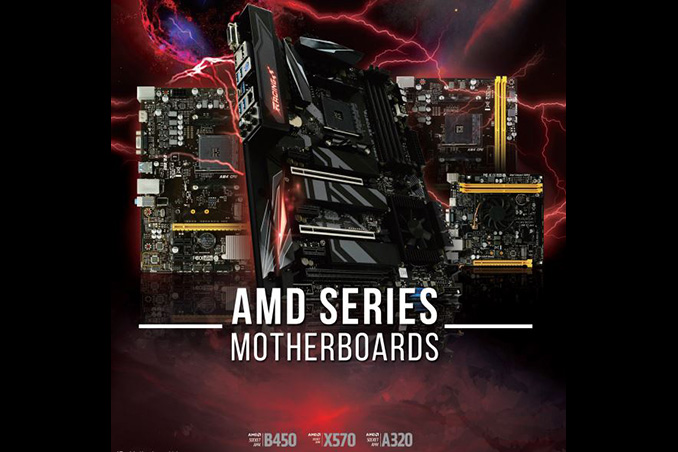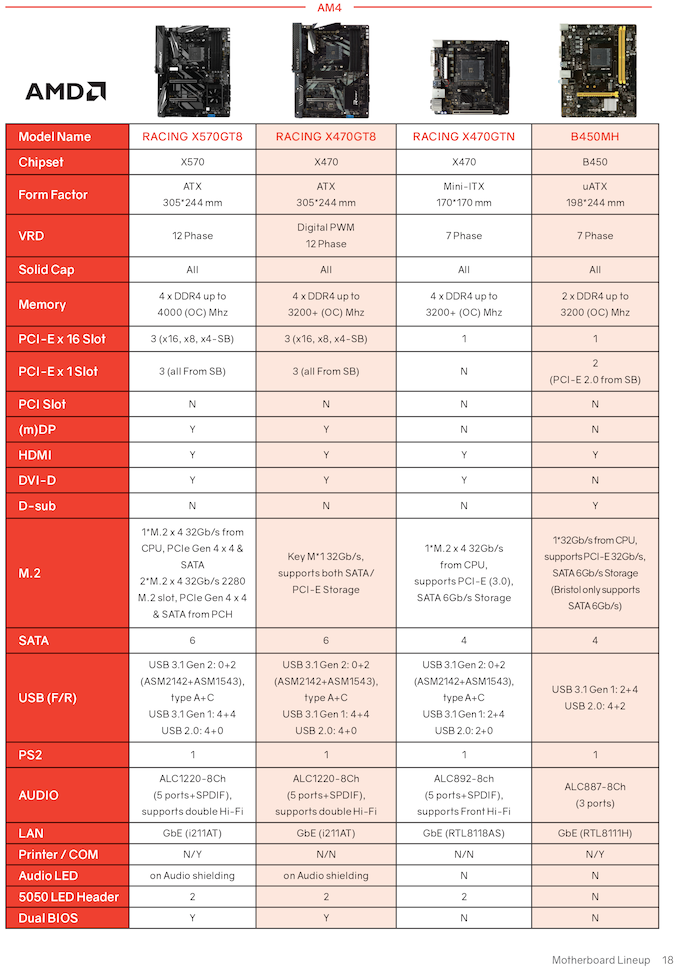Biostar Unveils Its X570 Racing GT8 Motherboard: PCIe Gen 4, DDR4-4000 and Triple M.2
by Gavin Bonshor on May 13, 2019 11:30 AM EST- Posted in
- Motherboards
- AMD
- Biostar
- 7nm
- PCIe 4.0
- Ryzen 3000
- X570
- X570 GT8
- DDR4-4000

It what seems to be an inadvertent move, Biostar has released information about its upcoming X570 Racing GT8 motherboard ahead of AMD's unveiling of the new X570 chipset. This announcement highlights certain specifications surrounding the X570 chipset and the X570 Racing GT8 itself including PCIe Gen 4, and support for high speed DDR4-4000 DDR4 memory.
While there's an element of mystery around the full and final details of the X570 chipset on AMD's AM4 socket, the unveiling of the X570 Racing GT8 motherboard confirms that X570 will feature PCIe 4.0. All told, it looks like the X570 Racing GT8 has three full-length PCIe slots, with two fed by the CPU supporting x16/x0 and x8/x8 configurations, the third full-length slot fed by the chipset at x4, and three PCIe 4.0 x1 slots. Biostar is advertising the X570 GT8 to feature a 12-phase power delivery which is fed by a pair of 12 V ATX power connectors which consists of an 8-pin and 4-pin.
The seemingly accidental reveal is interesting as the official specifications notes support for DDR4-4000 which leads us to believe that the IMC on the impending Ryzen 3000 series processors will feature a stronger memory controller (IMC) than the previous 2000 series. This makes things interesting as we found AMD's Infinity Fabric interconnect scaled well with memory frequency and with a higher standard surely to be set with the new 7nm manufacturing process, it could go one step further in regards to memory performance.
From the PDF file found on the official Biostar website initially spotted by VideoCardz, we know that the X570 Racing GT8 is ATX sized and will feature three M.2 slots PCIe 4.0 x4/SATA slots, with six SATA ports rounding off the storage capabilities. Design wise the board has a black PCB with grey printing and includes three buttons for power, resetting, with the function of the third button currently unclear. We don't know if the board has onboard RGB LED lighting, but we know that the X570 GT8 will have two RGB 5050 LED headers for users to utilize.
Also included is a Realtek ALC1220 8-channel HD audio codec which provides five 3.5 mm audio jacks and an S/PDIF optical output on the rear panel, as well as a single 1 GbE LAN port powered by an Intel I211-AT controller. For users looking to use AMD's Ryzen APUs, the rear panel also has a set of video outputs including a mini-DisplayPort, HDMI and DVI-D output. Due to the inclusion of the ASMedia ASM2142 and ASM1543 USB controllers, the Biostar X570 Racing GT8 will feature two USB 3.1 Gen2 ports (Type-A and Type-C) with four USB 3.0 Gen1 Type-A ports and four USB 2.0 ports. Users can expand upon this with an additional four USB 3.1 Gen1 Type-A ports and four USB 2.0 ports through the board's front-panel USB headers.
As it currently stands, the availability of the Biostar X570 Racing GT8 is unclear given that the X570 chipset hasn't officially been announced by AMD at present; this also stretches to the pricing as no information is currently available.
Related Reading
- AMD: "No Chipset APU Variant on Matisse, CPU TDP Range Same as Ryzen-2000"
- AMD Ryzen 3rd Gen 'Matisse' Coming Mid 2019: Eight Core Zen 2 with PCIe 4.0 on Desktop
- GIGABYTE X470 Aorus Gaming 7 WiFi-50 Motherboard Launched: Celebrating AMD's 50th Anniversary
- AMD: 7nm 'Navi' GPU & 'Rome' CPU to Launch in Q3
- Best Motherboards: Q1 2019
Via: VideoCardz











40 Comments
View All Comments
Hul8 - Tuesday, May 14, 2019 - link
Companies need some way to differentiate from other companies, so they add some impressive sounding word to their product name. Nothing wrong with that.People get used to any product/lineup name even if it sound stupid to begin with - just look at ROG.
Hul8 - Tuesday, May 14, 2019 - link
What kind of word you use doesn't matter much as long as it doesn't bring negative connotations. They just need *something*, so when people hear "Racing X570", they immediately think "Biostar".Hul8 - Tuesday, May 14, 2019 - link
I think most people buy based on price and features. Some consider performance and/or looks. Product name only bothers a small portion of the audience.ZoZo - Monday, May 13, 2019 - link
So if the chipset now provides PCI-E 4.0, what's the link between CPU and chipset? Hopefully, it's at least twice as fast as before.Dragonstongue - Monday, May 13, 2019 - link
https://forums.anandtech.com/threads/pcie-3-0-vs-4...so, in reference to increased speed, just because swap to new standard (3.0 to 4.0) does not automatically mean doubling of performance for chipset, if the increase ram wise spec is what is is, I can expect AMD to do ":similar: to what Intel normally does on an upping to new standard that is ~50% faster at most, but that also does not mean auto increase of what the overall system will give to you, if the memory bottleneck of dual channel - ddr4 - and Infinifty Fabric is to be "believed" as much as folks through around like it is the last load of poo they can chuck around.
simple "truth" AMD and Intel and Nv handle memory etc etc differently.
anyways, we will soon see, shan't we ^.^
DanNeely - Monday, May 13, 2019 - link
Not sure what you think you're talking about. The linked thread is about how much newer bus speeds will speed up GPUs (probably by a negligible amount in x16 slots despite what the creator implies in the 1st post); which is a totally different thing from how fast the databus is.Intel's DMI bus has been x4 PCIe equivalent from the beginning and has doubled in speed when it went from being derived from PCIe1.0 to 2.0, and doubled in speed again when it went to 3.0.
Since the 570 chipset can support a PCIe 4.0 x4 slot, it's upstream bandwidth is presumably at least PCIe 4.0 x4, or double what existing AMD chipsets offer. Barring evidence to the contrary though, I would assume it's still only 4 lanes wide for cost reasons. And while with SSDs able to saturate an x4 link there's a potential to bottleneck the chipset, with more IO (PCIe, sata, usb) on the CPU socket AMDs mainstream platform is less impacted by this than Intels.
lightningz71 - Tuesday, May 14, 2019 - link
Considering that existing NVME PCIe based SSDs can't currently saturate their existing 4xPCIe 3.0 lanes, unless they are doing a VERY short term burst from ram buffer, I suspect that the doubling of the CPU to chipset bandwidth by changing it to PCIe 4.0 will cover the throughput needs of the NVME drives on the chipset. This isn't to say that one can not ever cause bus contention on that link, just that it's a lot more difficult to do now than it was before.Please keep in mind, this is a consumer level chipset. If you're going to go after trying to stream data from one NVME drive on the chipset, process it on the CPU, then stream it back to another NVME drive on the chipset, all the while pulling information from a 10Gbps Ethernet card attached to a PCIe slot hung from that same chipset, process that information on the CPU, and stream it back out to a USB 3.1 device hung on the same chipset, while also live streaming 4K video from another USB 3.0 device out to a different network connection, you are definitely going to bottleneck the hell out of that CPU to chipset connection. But, if you're doing all of that, why are you using a consumer grade chipset? Wouldn't you be far better off with a threadripper or some sort of Xeon workstation grade solution?
AshlayW - Monday, May 13, 2019 - link
It will be PCI-E 4.0. Ryzen chipset -> CPU communication is handled by PCIE Express. The Ryzen Zeppelin die (1000,2000 series) has 4 dedicated lanes to communicate with the chipset. They are Gen3. It would be extremely weird if the 3000 series CPU had just Gen3 lanes for communicating with the chipset, because the CPU platform is 4.0 (and some of those lanes are used for that). Also would be a huge bottleneck for I/O. So expect 8GB/s bandwidth between X570 and CPU, minimum.haukionkannel - Monday, May 13, 2019 - link
It seems that infinity fabric is now the bottleneck and new chipset supports now halfspeed to memory speed to infinity fabric. So when the memoryspeed and infinity fabrig speed vere directly Connected in Ryzen 1000 and 2000 series now it is possible to reduce the infinity fabric speed to half. So you have to chose, take slow memory and run infinity fabric at full speed or take fast memory and run infinity fabric at half speed.We see interesting combinations and sometimes it is wice to take as fast memory as possible and sometimes memory that allows full speed to infinity fabric. Depending on what you use the computer!
schujj07 - Tuesday, May 14, 2019 - link
The infinity fabric speed has always been linked to the RAM clock.